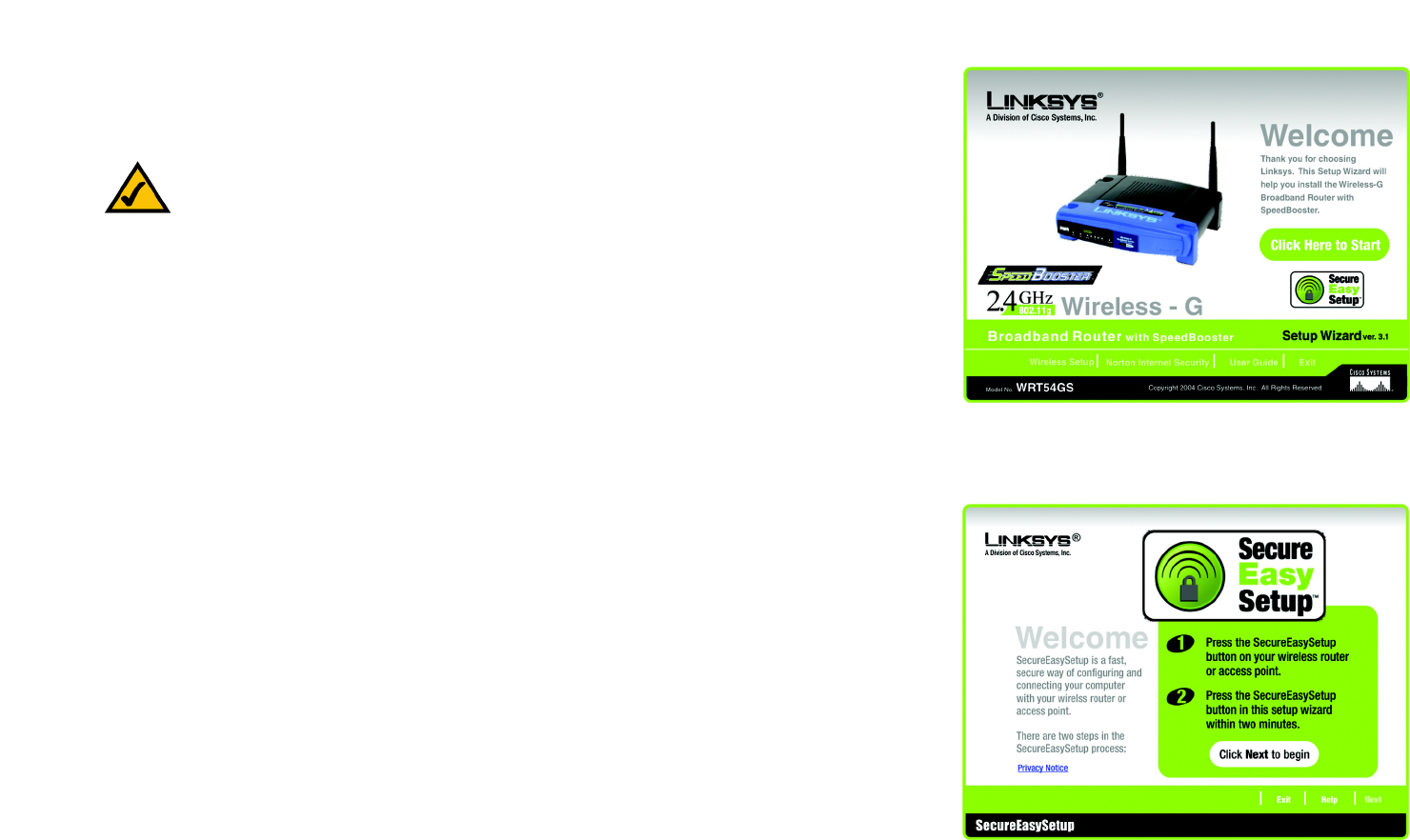LINKSYS WT54GV40 802.11G Broadband Router with SpeedBooster/Switch User Manual Book
LINKSYS LLC 802.11G Broadband Router with SpeedBooster/Switch Book
LINKSYS >
Contents
- 1. Users Manual 1
- 2. Users Manual 2
- 3. Users Manual 3
- 4. Users Manual 4
- 5. Users Manual 5
- 6. Users Manual 6
- 7. Users Manual 7
- 8. Users Manual 8
- 9. Users Manual 9
- 10. Users Manual 10
- 11. Users Manual 11
- 12. Users Manual 12
- 13. Users Manual 13
- 14. Users Manual 14
- 15. Users Manual 15
- 16. Users Manual 16
- 17. Users Manual 17
- 18. Users Manual 18
Users Manual 13

21
Chapter 5: Setting up the Wireless-G Broadband Router
Using the Setup Wizard
Wireless-G Broadband Router with SpeedBooster
Telstra
Connection - Telstra is a service used in Australia only. If you are using this service, select Telstra from the
drop-down menu.
User Name - Enter the User Name provided by your ISP.
Password - Enter the Password provided by your ISP.
Confirm - To confirm the Password, enter it again in this field.
Heart Beat Server - Enter the IP address of the Heart Beat Server server you are using (this should be
provided by your ISP).
Keep Alive - If you want the Router to periodically check your Internet connection, select Keep Alive. Then
specify how often you want the Router to check the Internet connection. If the connection is down, the Router
will automatically re-establish your connection.
Connect on Demand - If you want the Router to end the Internet connection after it has been inactive for a
period of time, select Connect on Demand and designate the number of minutes you want that period of
inactivity to last.
Click the Next button to continue or the Back button to return to the previous screen.
Figure 5-16: Setup Wizard’s Advanced Internet Settings -
Telstra Screen

22
Chapter 5: Setting up the Wireless-G Broadband Router
Using the Setup Wizard
Wireless-G Broadband Router with SpeedBooster
12. The Router provides a Web-based Utility you can use for configuring the Router from any networked PC.
Password - Enter a password that will control access to the Utility.
Confirm - Enter the password again in the Confirm field.
Click the Next button to continue or the Back button to return to the previous screen.
13. There are two ways to configure the Router’s wireless settings, SecureEasySetup and manual configuration.
If you have other SecureEasySetup devices, such as notebook adapters or printers, then you can use the
Router’s SecureEasySetup feature to create your wireless network. Proceed to the section, “Using the
Router’s SecureEasySetup Feature.”
If you do not have other SecureEasySetup devices, then proceed to the section, “Manually Configuring the
Router’s Wireless Settings.”
Figure 5-18: Setup Wizard’s Configure Wireless
Settings Screen
Figure 5-17: Setup Wizard’s Set the Router’s
Password Screen

23
Chapter 5: Setting up the Wireless-G Broadband Router
Using the Setup Wizard
Wireless-G Broadband Router with SpeedBooster
Using the Router’s SecureEasySetup Feature
Read these instructions before you press any SecureEasySetup buttons. You should locate the SecureEasySetup
buttons of your devices before using the Router’s SecureEasySetup feature.
1. Before you push any button, locate the SecureEasySetup button for each of your other SecureEasySetup
devices. If you are not sure where to find this button, click Where is my other SecureEasySetup button?
You will see a screen showing the SecureEasySetup logo. Click the Next button to continue or the Close
button to return to the Configure Wireless Settings screen.
You will see a screen with instructions on how to locate the SecureEasySetup hardware button. If your device
does not have a hardware button, it most likely will have a software button. Click the Next button for
instructions to locate the software button, or click the Close button to return to the Configure Wireless
Settings screen.
You will see a screen with instructions on how to locate the SecureEasySetup software button. Click the
Close button to return to the Configure Wireless Settings screen.
Figure 5-19: Setup Wizard’s SecureEasySetup Screen
Figure 5-20: SecureEasySetup Logo
Figure 5-21: Additional Information - Hardware Button
Figure 5-22: Additional Information - Software Button
NOTE: SecureEasySetup uses WPA-Personal encryption. If your current wireless devices do not
support WPA-Personal security, then you cannot use SecureEasySetup on your network. You will
need to manually configure your network security using the encryption supported by your
existing devices.

24
Chapter 5: Setting up the Wireless-G Broadband Router
Using the Setup Wizard
Wireless-G Broadband Router with SpeedBooster
2. Press the Router’s orange Cisco logo on its front panel. When the logo turns white and begins to flash, press
the SecureEasySetup button on another device. The Router’s Cisco logo will stop flashing when the device
has been added to the network. Then repeat this procedure for each additional SecureEasySetup device.
When you have finished configuring the devices in your wireless network, click the Next button to continue.
3. The Setup Wizard will ask you to review your settings before it saves them. Write down these settings if you
need to manually configure any non-SecureEasySetup devices.
Click the Yes button if you are satisfied with your settings, or click the No button if you do not want to save
your new settings.
Figure 5-23: Setup Wizard’s Configure Wireless
Settings Screen
Figure 5-24: Setup Wizard’s Confirm New Settings Screen
NOTE: You can only add one SecureEasySetup device at a time.

25
Chapter 5: Setting up the Wireless-G Broadband Router
Using the Setup Wizard
Wireless-G Broadband Router with SpeedBooster
4. After the settings have been saved, the Safe Surfing screen will appear. Click the Norton Internet Security
Suite button to install the special edition of Norton Internet Security on your computer, or click the Finish
button to complete the Setup Wizard.
5. The Congratulations screen will appear. Click the Online Registration button to register the Router, or click
the Exit button to exit the Setup Wizard.
Congratulations! The installation of the Wireless-G Broadband Router with SpeedBooster is complete.
If you want to make advanced configuration changes, proceed to “Chapter 6: Configuring the Wireless-G
Broadband Router with SpeedBooster.”
Figure 5-25: Setup Wizard’s Safe Surfing Screen
Figure 5-26: Setup Wizard’s Congratulations Screen

26
Chapter 5: Setting up the Wireless-G Broadband Router
Using the Setup Wizard
Wireless-G Broadband Router with SpeedBooster
Manually Configuring the Router’s Wireless Settings
1. If you do not have other SecureEasySetup devices, then click the Enter Wireless Settings Manually button.
2. The Setup Wizard will ask you to enter the settings for your wireless network.
In the SSID field, enter the name of your wireless network. The SSID must be identical for all devices in the
network. The default setting is linksys (all lowercase).
Select the operating channel for your wireless network. All of your wireless devices will use this channel to
communicate.
From the Network Mode drop-down menu, select the wireless standards running on your network. If you have
both 802.11g and 802.11b devices in your network, keep the default setting, Mixed Mode. If you have only
802.11g devices, select G-Only. If you have only 802.11b devices, select B-Only. If you want to disable your
wireless network, select Disable.
Enter a name for the Router in the Device Name field.
Click the Next button to continue or the Back button to return to the previous screen.
NOTE: An SSID is the network name shared by all devices in a wireless network. Your network’s
SSID should be unique to your network and identical for all devices within the network.
Figure 5-27: Setup Wizard’s Configure Wireless
Settings Screen
Figure 5-28: Setup Wizard’s Wireless Settings Screen

27
Chapter 5: Setting up the Wireless-G Broadband Router
Using the Setup Wizard
Wireless-G Broadband Router with SpeedBooster
3. Select the method of security you want to use: WPA-PSK (also called WPA-Personal), WEP (64-Bit), or WEP
(128-Bit). WPA stands for Wi-Fi Protected Access, and WEP stands for Wired Equivalent Privacy. WPA is a
stronger security method than WEP. Proceed to the appropriate section for your security method.
If you want to use WPA-RADIUS (also called WPA-Enterprise), then you should select Disabled and use the
Router’s Web-based Utility to configure your wireless security settings. Click the Next button and proceed to
step 4.
If you do not want to use any wireless security method, select Disabled and then click the Next button.
Proceed to step 4.
WPA-PSK
WPA-PSK offers two encryption methods, TKIP and AES, with dynamic encryption keys. Select TKIP or AES
for encryption. Then enter a Passphrase that is 8-32 characters in length.
Encryption - Select the type of algorithm you want to use, TKIP or AES, from the Encryption drop-down
menu.
Passphrase - Enter a Passphrase, also called a pre-shared key, of 8-32 characters in the Passphrase field.
The longer and more complex your Passphrase is, the more secure your network will be.
Click the Next button to continue or the Back button to return to the previous screen.
radius (remote authentication dial-in user service): a
protocol that uses an authentication server to control
network access.
wep (wired equivalent privacy): a method of
encrypting network data transmitted on a
wireless network for greater security.
wpa (wi-fi protected access: a wireless security
protocol using TKIP (Temporal Key Integrity Protocol)
encryption, which can be used in conjunction with a
RADIUS server.
encryption: encoding data transmitted in a network.
Figure 5-29: Setup Wizard’s Wireless Security -
WPA-PSK Screen

28
Chapter 5: Setting up the Wireless-G Broadband Router
Using the Setup Wizard
Wireless-G Broadband Router with SpeedBooster
WEP (64-Bit)
Enter a passphrase or WEP key.
Passphrase - Enter a passphrase in the Passphrase field, so a WEP key is automatically generated. The
passphrase is case-sensitive and should not be longer than 16 alphanumeric characters. It must match the
passphrase of your other wireless network devices and is compatible with Linksys wireless products only. (If
you have any non-Linksys wireless products, enter the WEP key manually on those products.)
WEP Key - The WEP key you enter must match the WEP key of your wireless network. For 64-bit encryption,
enter exactly 10 hexadecimal characters. Valid hexadecimal characters are “0” to “9” and “A” to “F”.
Click the Next button to continue or the Back button to return to the previous screen.
WEP (128-Bit)
Enter a passphrase or WEP key.
Passphrase - Enter a passphrase in the Passphrase field, so a WEP key is automatically generated. The
passphrase is case-sensitive and should not be longer than 16 alphanumeric characters. It must match the
passphrase of your other wireless network devices and is compatible with Linksys wireless products only. (If
you have any non-Linksys wireless products, enter the WEP key manually on those products.)
WEP Key - The WEP key you enter must match the WEP key of your wireless network. For 128-bit encryption,
enter exactly 26 hexadecimal characters. Valid hexadecimal characters are “0” to “9” and “A” to “F”.
Click the Next button to continue or the Back button to return to the previous screen.
4. The Setup Wizard will ask you to review your settings before it saves them. Click the Yes button if you are
satisfied with your settings, or click the No button if you do not want to save your new settings.
Figure 5-30: Setup Wizard’s Wireless Security -
WEP (64-Bit) Screen
Figure 5-32: Setup Wizard’s Confirm New Settings Screen

29
Chapter 5: Setting up the Wireless-G Broadband Router
Using the Setup Wizard
Wireless-G Broadband Router with SpeedBooster
5. After the settings have been saved, the Safe Surfing screen will appear. Click the Norton Internet Security
Suite button to install the special edition of Norton Internet Security on your computer, or click the Finish
button to complete the Setup Wizard.
6. The Congratulations screen will appear. Click the Online Registration button to register the Router, or click
the Exit button to exit the Setup Wizard.
Congratulations! The installation of the Wireless-G Broadband Router with SpeedBooster is complete.
If you want to make advanced configuration changes, proceed to “Chapter 6: Configuring the Wireless-G
Broadband Router with SpeedBooster.”
Figure 5-31: Setup Wizard’s Norton Screen
Figure 5-33: Setup Wizard’s Congratulations Screen

30
Chapter 5: Setting up the Wireless-G Broadband Router
Using SecureEasySetup to Configure Your Notebook
Wireless-G Broadband Router with SpeedBooster
Using SecureEasySetup to Configure Your Notebook
This section explains how to use SecureEasySetup if you have a computer displaying the SecureEasySetup logo.
1. After you have clicked Wireless Setup on the Welcome screen, the first screen that appears will describe the
two steps you will take to configure your notebook. Click the Next button to continue.
To exit the Wireless Setup Wizard, click the Exit button. If you need more information, click the Help button.
Figure 5-35: SecureEasySetup Welcome Screen
NOTE: SecureEasySetup uses WPA-Personal encryption. If your current wireless devices do not
support WPA-Personal security, then you cannot use SecureEasySetup on your network. You will
need to manually configure your network security using the encryption supported by your
existing devices.
Figure 5-34: Setup Wizard’s Welcome - Start
Wizard Screen